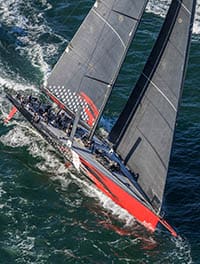The 100-foot race boat Comanche completed a record run to Bermuda in the early morning hours of June 19. Comanche cut almost 5 hours off of the previous best time in the Newport/Bermuda Race. Ken Read, Comanche’s skipper, said their success was the result of a number of factors. He pointed to the total commitment of owners Jim and Kristy Hinze Clark, to a boat that was built especially for breaking records, to a crew of experienced professionals, and to Stan Honey, who Read called the world’s best navigator.
Comanche crossed the finish line off St. David’s Lighthouse June 19th at at 4:22:53 EDT. With Read calling the tactics, Comanche finished the race in a provisional 34 hrs 42 min 53 sec, almost five hours faster than the previous 39:39:18 record set by George David’s Rambler in 2012. Honey was able to find an opening in the high pressure ridge that stretched across the rhumb line on the opening night of the race and trapped the rest of the fleet north of the fresher breeze above the Gulf Stream.
“Stan and I have a great working relationship,” Read said. “I love the tactical side of the navigation and he does the weather side. Breaking records is important to us as much as it is to Jim Clark, who followed the race every second of the way and called us on the boat two minutes after we finished!”
“Looking at the weather three days before the start, it looked like we would have a pretty good run at the record. One thing that concerned us was the late start and the wind shift that would go with it. There was a high pressure cell building across the course. With an earlier start we could have beaten the high, started on port tack and stayed on it all the way to Bermuda. Even if it was a sea breeze day, the wind would have been fading. That late start cost us four or five hours. We could have beaten that little high out on the easterly breeze but because of the delay, we had to take a left turn and go out and around it.”
Read said that Honey found a gap that separated the high cells and allowed Comanche to get just ahead of the ridge rather than going all the way around. “When we escaped, all of a sudden the hard part was over. The boat did it’s job.”
“The boat is just as good as it looks," Read added. “She’s a big, wide, beamy boat that eats up miles on a reach. We were averaging 28 to 29 and our highest speed was 32 knots. If it is blowing 28 knots we’re doing 28. At wind speeds in the 14 knot range, we outsail the wind by four knots or more. But you can’t sail a boat like this without a great crew. Kasey Smith is the boat captain and I have been around the world with him twice. I wouldn’t leave the dock without Kasey.”When asked to comment on his plan Stan Honey explained, “Because our start was so late, the northeaster wasn’t going to fill in all the way to the shore in the evening. There was a highpressure ridge building south of Newport, walling off the course. We carefully went through all the weather files and compared them to the models and weather buoys and our own observations. We found one that worked well for us.”
“There was a portion where two little highs had separated with a bit of a hole in between. We sailed around the edge of the western high, gybing around it and never got below eight knotts of wind. We gybed twice, actually.” Honey said.
Read added, “We expected to be drifting which would have killed our record hopes. But all of a sudden we pop out of the other side and it’s like— There is a God… let’s get out of here!”
Both Read and Honey were concerned that if this had been a conventional race with the boats clumped together in the beginning, their late start would have had them sailing through the slower boats in the dark. Fortunately, the fleet was spread out early due to wind shifts. “It’s one thing in the Fastnet Race, but that is a daytime start and you can make hand signals to tell other boats that you are going to dip them, but that doesn’t work at night.”
The largest waves the Comanche saw in the Gulf Stream were just about 10 feet and the highest winds in the mid 30’s. After avoiding the high pressure ridge, which kept many other competitors away from new wind in the Gulf Stream, the race was a reach to Bermuda.
Owners Jim and Kristy Hinze Clark plan to attend the prize ceremony at the Bermuda Governor’s house on Saturday June 25th. Read has already returned to his day job as President of North Sails to build a mainsail with a 300 foot luff for a new sloop. Comanche is headed back to Newport to prepare for a transAtlantic monohull record attempt later this summer.

